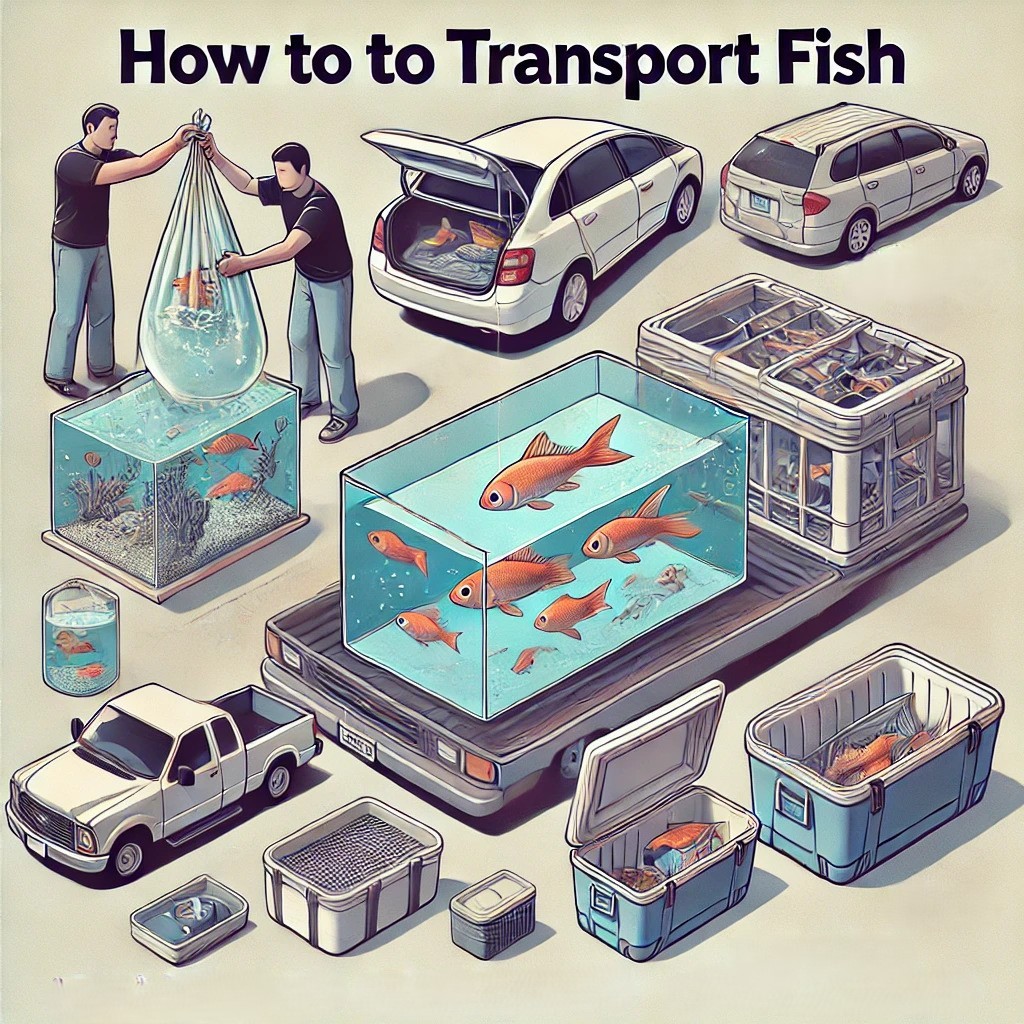Moving doesn’t have to be stressful when you’re well-prepared. Every creature, no matter how small, deserves a smooth transition to their new home.
Fish are beautiful creatures that bring a sense of peace to our surroundings but they are also delicate. If you’re moving and need to transport your fish, they can usually survive up to 48 hours in transit. To do this safely, you’ll need the right preparation and containers. Keep in mind that professional movers cannot transport fish. If you’re driving and your trip is less than 48 hours, you can take your fish along with you in the car. However, make sure to never leave them unattended overnight.
For trips longer than two days, you may need to consider other options. One idea is to fly with your fish but make sure to check the airline’s rules as each airline has its own regulations. Some pet stores may offer boarding services and can ship your fish by air if needed. You could also use services like UPS, FedEx, or USPS to transport them.
It’s a good idea to book early when flying, as airlines have limits on the number of pets allowed per flight and there may be fees involved. Also, check state regulations to ensure your fish species is permitted in your destination state or any states you pass through during your journey.
Preparing Your Fish for Travel
Fish are delicate travelers, but with the right care and attention, they can thrive in their new environment just as much as we do.
Before moving your fish, there are a few important steps to ensure their safe transportation.
- Change the Water: About five days before moving, replace 20% of the water in the aquarium to make sure it stays clean and fresh for your fish.
- Do Not Feed Your Fish: One to two days before the move, stop feeding your fish. They can survive without food for about seven days and this helps keep the water cleaner.
- Timing: Pack your fish last. They should be the final thing you take care of before leaving, as they need to spend as little time in transit as possible. Once you arrive, unpack your fish first.
Transportation Options for Your Fish
There are a few ways to transport your fish safely:
Plastic Bags:
- You can use special plastic bags from pet stores.
- Fill the bag one-third with water from the aquarium. Each fish should have its own bag—never put more than one fish in a bag.
- Double-bag the fish by placing a second plastic bag around the first one for extra protection.
- Secure the bags with a rubber band.
- If the fish will be in the bags for over an hour, add pure oxygen to the bags.
Buckets:
- For multiple fish, use a 5-gallon bucket (make sure it’s new and never had chemicals in it).
- Fill the bucket with water from your aquarium and ensure it has a tight, water-sealed lid.
Containers:
- A sturdy container with a secure lid can also be used. This is a good option for fish with sharp fins.
- Again, use water from your aquarium and make sure there’s enough space for the fish to move around.
Moving the Tank:
- If you have a small aquarium, you can move it with the fish and some water inside.
- For large tanks, do not move them with fish inside. First, remove the filter, rocks, plants and decorations. Then, drain some of the water.
- Tanks are fragile, so there’s a risk of dropping and damaging them which could harm your fish.
Moving Live Plants
If you have live plants in the aquarium, place them in plastic bags with water from the tank to keep them alive. This also preserves the beneficial bacteria.
Providing Enough Oxygen
Whether you’re using a plastic bag, bucket or container make sure there is enough space for the fish to swim and for air. Fill one-third of the container with water and leave the rest for oxygen. If transporting in bags or small containers, use a secure, insulated carrier like a Styrofoam cooler. You can use bubble wrap to prevent the bags from shifting during transport.
These steps will help ensure your fish are safe and comfortable during the move.
For more detailed guidance, you can refer to resources like the American Veterinary Medical Association (AVMA), which offers helpful information on this topic.
Traveling with Your Fish
When moving your fish, it’s essential to ensure their safety and keep the water at a stable temperature. If you are traveling by car make sure the fish are in a spot where they can benefit from the car’s air conditioning or heating depending on the weather.
To keep your fish calm during the trip, consider creating a darker environment by covering their container with a sheet or cloth. This can reduce their activity and help them stay less stressed.
Arriving at Your New Home
Once you arrive at your new home, the first priority should be unpacking your fish. Set up the tank or aquarium placing all decorations, rocks and objects back inside. Reinstall any filters, pumps and heaters. If you have live plants, they can also be placed back into the tank.
If you transported your fish in a bucket, you can pour both the water and fish directly into the tank or use a net to transfer the fish. If you used plastic bags, let the bags float in the new tank water to help equalize the temperature. Once the water in the bags matches the tank’s water, you can release the fish into the tank.
With your fish settled in, you can then start unpacking the rest of your belongings, knowing your fish are safe in their new home.
FAQs: Transporting Fish
How to transport fish in a car?
To transport fish in a car, place them in a secure container like a plastic bag, bucket or small tank. Keep the container stable and make sure to use the car’s air conditioner or heater to maintain a comfortable temperature. If you’re relocating in or around Chicago, professional services like Chicago Movers Near Me can help guide you through the process, even though moving companies generally don’t transport pets, including fish.
How to transport fish when moving?
When moving with fish, prepare them by changing 20% of the water a few days before the move. Transport fish in plastic bags or buckets using water from their tank. Pack the fish last and unpack them first at your new home. Set up their tank before introducing them back into the water.
How to transport fish in a car long distance?
For long-distance trips, use insulated containers to keep the water temperature stable. Pack only one-third of the container with water, leaving space for air. During longer moves, you might need to stop for breaks making sure your fish are safe. You can reach out to Chicago Movers Near Me for tips on managing your moving process efficiently.
How to transport fish long distance?
For longer distances, fish can be transported in well-sealed plastic bags with pure oxygen added. Alternatively, use a bucket with a tight lid. If the journey exceeds 48 hours, consider flying with your fish or using a specialized service like a pet shipping company.
How are fish transported to pet stores?
Fish are typically transported to pet stores in sealed plastic bags filled with water and pure oxygen. These bags are placed in insulated boxes or containers to maintain a stable temperature during transit.
How to safely transport a betta fish?
To transport a betta fish, use a small container with a lid, such as a cup or bag and fill it with water from their current tank. Ensure the water is at the right temperature and cover the container to reduce stress. For longer trips use an insulated carrier.
How to transport a fish on a plane?
When transporting fish on a plane, check the airline’s policies first. Pack the fish in a clear, leak-proof plastic bag with pure oxygen and place it in an insulated container. Ensure the container meets the airline’s regulations and book early to secure a spot for your pet.
How to transport big fish?
For large fish, use a sturdy container like a large bucket or specialized fish transport container. Fill the container partially with water from their tank and ensure it has a secure lid. Make sure the container is well-insulated and large enough for the fish to move comfortably.
How to transport fish across country?
When transporting fish across the country, it’s best to use an airline or specialized pet transportation service. Pack the fish in insulated containers with enough water and oxygen. For road trips, ensure the containers are stable and the temperature remains consistent.
How to transport fish short distances?
For short distances, fish can be moved in plastic bags or small containers with water from their tank. Keep the container steady in the car and maintain a stable temperature. Unpack the fish quickly upon arrival and reintroduce them to their tank.
The road may be long but with the right preparation, even the smallest of travelers can make it safely to their destination.



